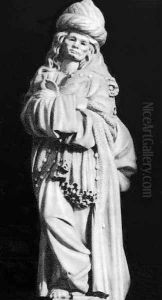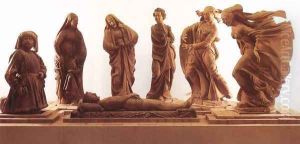Niccolo Dell' Arca Paintings
Niccolò dell'Arca, an Italian early Renaissance sculptor, was born in Bari, Italy, around 1435-1440. Little is known about his early life and training, but he is often associated with the sculptural traditions of both Bari and Naples, suggesting that he may have been exposed to a blend of Northern and Southern Italian artistic influences. He earned his name 'dell'Arca' because of the mastery he demonstrated in sculpting terracotta, a medium that was relatively less prestigious than bronze or marble but in which dell'Arca showed unparalleled skill. The name 'dell'Arca' literally translates to 'of the Ark,' referencing his work on the Ark of St. Dominic in Bologna, though this nickname was retrospectively applied and not used during his lifetime.
Niccolò dell'Arca's work is characterized by a dramatic expressiveness and a dynamic sense of movement, qualities that set him apart from many of his contemporaries who favored more serene and harmonious compositions. One of his most famous works, the Lamentation over the Dead Christ (also known as the Compianto sul Cristo Morto), located in the Sanctuary of Santa Maria della Vita in Bologna, showcases this distinctive style. Created towards the end of the 15th century, this group of terracotta figures is remarkable for its intense emotional expressivity and the detailed depiction of grief on the figures’ faces and postures, reflecting the influence of Northern European art as well as foreshadowing the emotional intensity of the Baroque period.
Despite his significant contributions to the Renaissance sculptural landscape, details about Niccolò dell'Arca's life remain sparse, and his work was somewhat overshadowed by the later achievements of contemporaries such as Donatello and Michelangelo. However, his innovative approach to terracotta and his ability to convey complex human emotions through sculpture have earned him a respected place in art history. Niccolò dell'Arca died in Bologna in 1494, leaving behind a legacy that has been appreciated more in the centuries following his death, as art historians and critics have come to recognize the depth and originality of his work.

